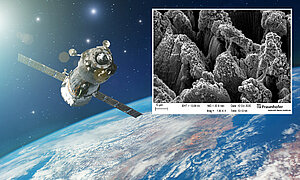July 2, 2021
The Fraunhofer Heinrich Hertz Institute (HHI), together with Azimut Space GmbH, has won a research announcement by the European Space Agency (ESA). The institute's technology was selected from numerous submissions to send material samples to the International Space Station (ISS). The department "Fiber Optical Sensor Systems" at Fraunhofer HHI will send three different metal samples to the ISS. The samples’ surfaces were structured using femtosecond laser processes. They are highly efficient in the dissipation of heat, opening up new possibilities for temperature regulation in space applications. The samples were delivered to ESA in June and will be flown to the ISS in 2022 after a period of extensive testing.
The research announcement is a joint project between ESA and the French space agency CNES. It is aimed at European scientists who want to test harmful effects of space on their materials. The samples will be attached to the new ISS platform "Bartolomeo". Bartolomeo is a commercial platform mounted on the outside of the Columbus module of the ISS. The project's goal is to gain a better understanding of how different materials age outside of the Earth's atmosphere.
Due to the vacuum, the transfer of heat to the environment by heat conduction is not possible in space. This poses a problem for any kind of space-qualified electronics, leading them to overheat quickly. The only way to cool down these electronics is to radiate their heat directly into space. To achieve this, heat is converted into thermal radiation by a radiator. For this process to work efficiently, the material used must emit the maximum amount of thermal radiation.
At present, special coatings are used for this purpose. However, these no longer function at high temperatures, such as those reached by rocket nozzles. Furthermore, the service life of coatings is significantly shortened by the special physical and chemical changes triggered by exposure to space.
One alternative to coatings is surface processing, for example via laser structuring. The researchers in the "Fiber Optical Sensor Systems" department at Fraunhofer HHI are experts in this field. In the preceding project BLAST, they were able to use femtosecond laser processes to functionalize various metal surfaces so that their heat dissipation is highly efficient.
The researchers chose aluminum, titanium and stainless steel because these highly stable metals are already used for space exploration. The metals are irradiated with a laser, which vaporizes part of the surface. Due to the extremely short time-scale of the laser pulses of a few femtoseconds, the metals remain undamaged. Cones smaller than one micrometer are lasered into the previously smooth surface. This process has the great advantage that the surface is physically optimized, but the material is not chemically altered. This is especially attractive for space applications, since any change in the source material requires years of testing before it can be used in space.
The surfaces structured by Fraunhofer HHI have already passed tests of up to 650 degrees Celsius. Further examinations are working with even higher temperatures. First commercial applications are already being planned in collaboration with Azimut Space GmbH. One future application is a box made of aluminum for power electronics of satellites. Additionally, rocket nozzles can be processed with the method developed by Fraunhofer HHI.
